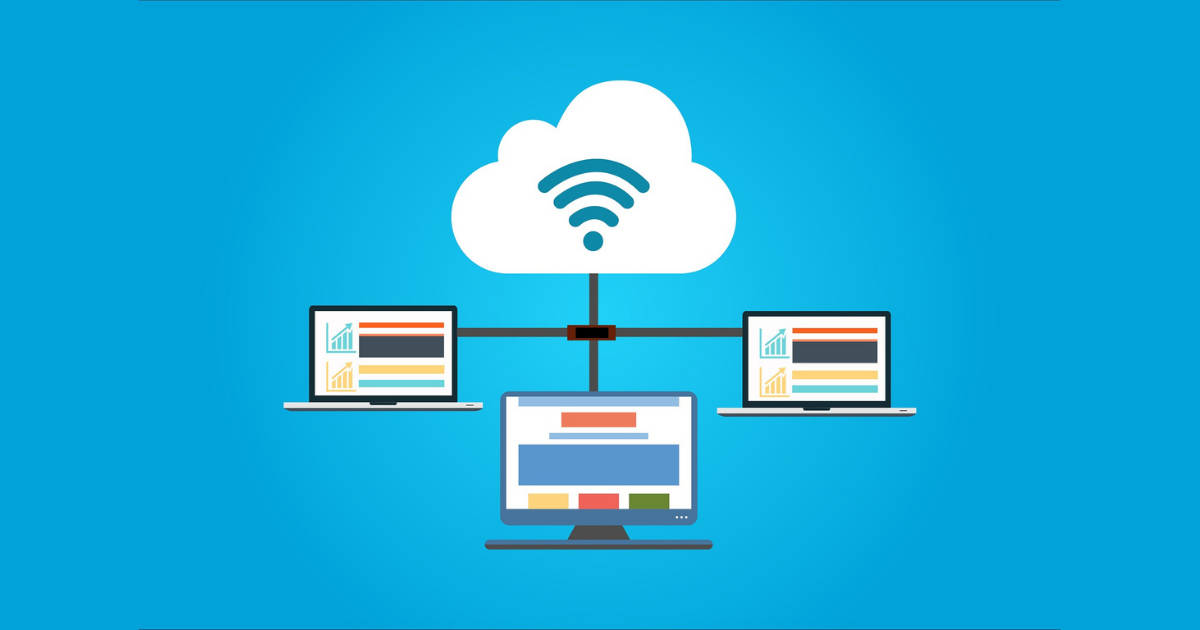Quantum computing holds immense potential for revolutionizing processing power, particularly in machine learning. This article shows how quantum machine learning leverages the unique capabilities of quantum computers to process and store vast amounts of data exponentially faster than classical computers. Despite quantum computing being in its early stages, there are already accessible cloud-based solvers and open-source software options, making quantum machine learning more accessible and promising for industries and businesses seeking to integrate advanced machine learning applications into their operations. In this article, we are going to look at free quantum machine learning software.
Table of Contents
Qiskit
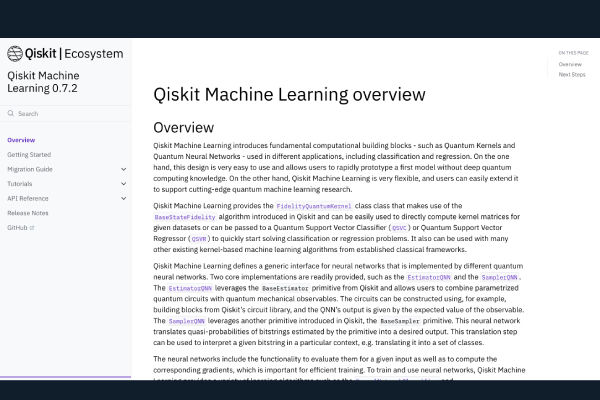
IBM offers an open-source software development kit called Qiskit that can be used to program quantum computers and their hardware. A number of fundamental quantum programming primitives are included in the core Qiskit package. Qiskit Extensions are community-maintained projects that add more functionality, like simulators and applications.
Features of Qiskit
- It offers a selection of tools and modules. For creating and executing quantum programs for a variety of uses, such as quantum simulation, encryption, machine learning, finance, and gaming.
- Quantum simulation: Researchers can simulate sophisticated quantum systems that are impossible to simulate on classical computers with the help of Qiskit’s high-performance simulators.
- Quantum cryptography: Qiskit makes it possible to create safe communication protocols that use the special qualities of quantum systems to guarantee the integrity and confidentiality of the data that is sent.
Pros
- Qiskit is an open-source framework that allows anyone to use, modify, and contribute to its codebase for software development.
- It offers versatility with tools and modules for developing applications in quantum simulation, cryptography, machine learning, finance, gaming, and more.
- Qiskit Studio provides a user-friendly experience where users can create, visualize, and manipulate quantum circuits without writing any code, thanks to its intuitive graphical user interface (GUI).
Cons
- Limited qubit count in current quantum systems can make executing or simulating large quantum computations challenging.
- Noise in real quantum hardware can significantly impact the precision and reliability of quantum computations.
- The complexity of quantum computing requires a high level of expertise and a deep understanding of quantum mechanics to develop quantum algorithms and applications effectively.
Cirq

A Python software package called Cirq is used to create, modify, and optimize quantum circuits, which are subsequently executed on quantum simulators and computers. With today’s noisy intermediate-scale quantum computers, where hardware specifications are crucial to attaining cutting-edge performance, Cirq offers helpful abstractions.
Features of Cirq
- Cirq provides resources for building, modeling, and running quantum circuits on both quantum simulators and actual quantum computers.
- It is compatible with various quantum hardware platforms, including Google’s quantum processors and simulators like the TensorFlow Quantum simulator.
- Developers find it easier to work with quantum algorithms using Cirq’s high-level abstractions for defining quantum circuits, gates, and operations.
- Cirq integrates seamlessly with TensorFlow, allowing the inclusion of quantum circuits in TensorFlow computational networks, simplifying the training of quantum models alongside traditional machine learning methods.
Pros
- An adaptable structure is ideal for study and testing.
- Smooth integration of training and optimization using TensorFlow.
- Community support and active development.
- Adherence to diverse quantum hardware platforms.
Cons:
- A steep learning curve, particularly for people who are not familiar with quantum computing.
- Absence of high-level abstractions and optimization methods built in.
- Limited assistance with quantum algorithm simulations using classical methods.
- The possibility of incompatibilities in the quickly changing field of quantum computing.
Also read: 10 Most-Popular Free Cloud-based Quantum Machine Learning Software (2024)
Apache Spark
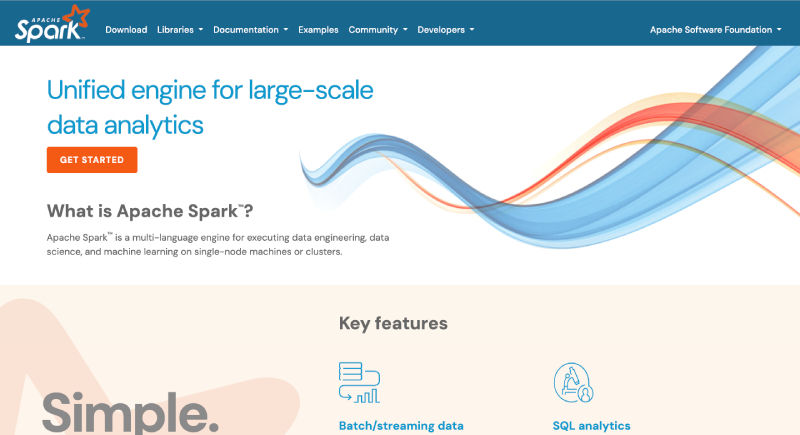
The Scala-written scalable machine learning library for Apache Spark is called MLlib. It offers several different methods for collaborative filtering, clustering, regression, and classification.
These are Apache Spark’s three main characteristics:
Features of Apache Spark
- Apache Spark accelerates data processing through in-memory processing, improving performance and enabling faster iterative processing due to data retention in memory.
- With a unified analytics engine, Spark supports diverse workloads like machine learning, batch processing, real-time streaming, and graph processing, streamlining data analysis within a single framework.
- Spark ensures fault tolerance through resilient distributed datasets (RDDs), automatically recovering from errors and providing reliable data processing for mission-critical applications, even in remote computing environments.
Pros
- High performance due to in-memory processing.
- Versatility with support for various data processing workloads.
- Fault tolerance through resilient distributed datasets (RDDs).
Cons
- Steeper learning curve compared to traditional MapReduce frameworks.
- Memory-intensive, requiring sufficient RAM for optimal performance.
- Complexity increases with the scale of the data and cluster size.
PyTorch

Developed by Facebook’s AI Research lab, PyTorch is an open-source machine learning library known for its dynamic computation graph and easy-to-use API.
Features of PyTorch
- PyTorch uses dynamic computation graphs, offering flexibility and intuitive model creation, simplifying debugging, and enabling dynamic control flow and graph building.
- With GPU acceleration, PyTorch provides fast tensor computations, greatly speeding up training and inference times for deep learning models.
- Its Pythonic interface integrates seamlessly with other Python frameworks and modules, benefiting machine learning researchers, practitioners, and developers with interactive debugging and a straightforward syntax.
Pros:
- Intuitive and Pythonic interface for ease of use and integration with other Python libraries.
- Dynamic computation graphs provide flexibility and ease of debugging during model development.
- Efficient tensor computation with GPU acceleration for fast and scalable deep learning operations.
Cons:
- Higher memory consumption compared to static graph frameworks like TensorFlow.
- Limited built-in deployment tools and production support compared to some other frameworks.
- Smaller community and ecosystem compared to TensorFlow, potentially leading to fewer resources and tutorials.
Scikit-learn
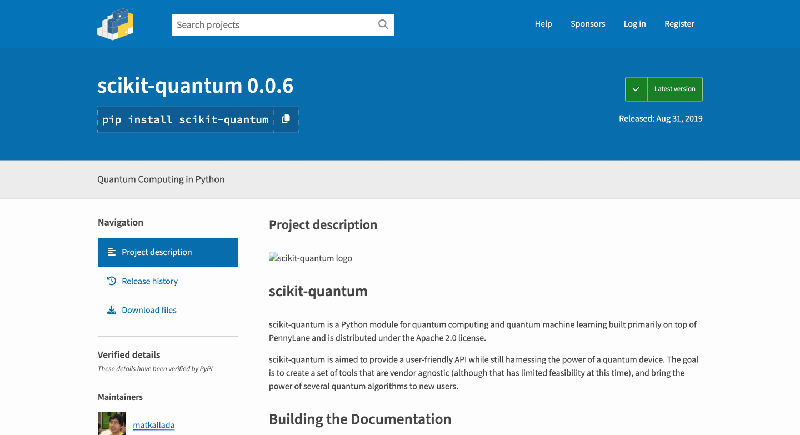
This Python module offers straightforward and effective data mining and analysis techniques. NumPy, SciPy, and matplotlib serve as its foundation.
Features of Scikit-learn
- Scikit-learn offers easy-to-use tools with an intuitive interface and effective implementation of machine learning algorithms, catering to both beginners and experts.
- It provides a wide range of techniques, including model selection, dimensionality reduction, regression, clustering, and classification, covering various supervised and unsupervised learning tasks.
- Scikit-learn seamlessly integrates with the Python ecosystem, combining its machine learning capabilities with libraries like NumPy, SciPy, and matplotlib for scientific computing, data manipulation, and visualization.
Pros
- On the scikit-learn website, users who wish to integrate the algorithms with their platforms can find comprehensive documentation about the API.
- Scikit-learn is updated and supported by a huge international online community of writers and contributors.
- It’s easy to use.
- The library is freely available with the least restrictive licensing and legal restrictions thanks to its BSD license.
Cons
- Not the best option for someone who wants to study in-depth.
- Offers a basic abstraction that can persuade less experienced data scientists to move forward without first mastering the fundamentals.
Also read: Creating Personalised Email Communication Using AI and Machine Learning
Keras
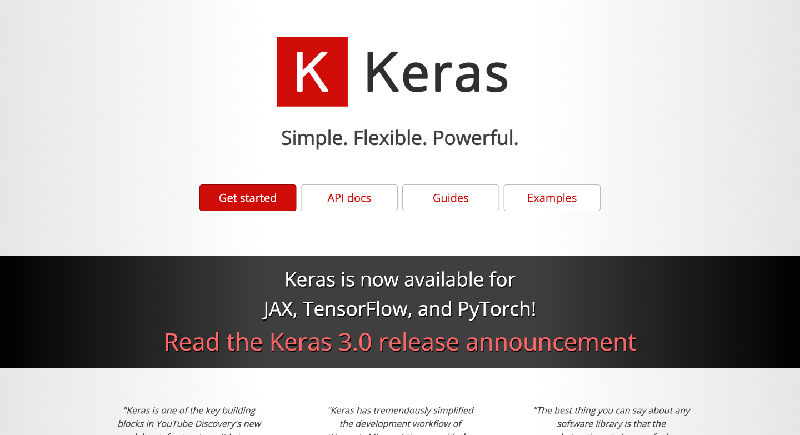
It’s a Python neural network module that is freely available. It is renowned for being user-friendly and for making prototyping simple and quick.
Features of Keras
- Keras offers a user-friendly API for deep learning tasks, simplifying model construction, training, and deployment without requiring users to delve into low-level implementation details.
- Its modular approach allows users to combine various layers, optimizers, loss functions, and activation functions, making it flexible for creating custom neural network architectures suitable for diverse tasks such as convolutional and recurrent networks.
- With its integration into TensorFlow, users can leverage the scalability and computational power of TensorFlow’s backend while benefiting from Keras’s simplicity and ease of use, allowing for seamless switching between the two libraries.
Pros
- User-friendly API for easy prototyping and experimentation.
- Modular architecture allows for flexible model customization.
- Integration with TensorFlow provides scalability and performance.
Cons
- Limited support for low-level customization compared to TensorFlow.
- May not be the best choice for complex research-oriented projects.
- Some advanced features may require knowledge of TensorFlow internals.
IBM Watson Studio

IBM Watson Studio is a platform that enables subject matter experts, application developers, and data scientists to work together and efficiently with data to create, train, and implement models.
Features of IBM Watson Studio
- IBM Watson Studio offers a unified platform where data scientists, developers, and domain experts collaborate on data tasks, model development, and deployment within a single environment.
- Leveraging AutoAI, Watson Studio accelerates model creation by automating algorithm selection, hyperparameter tuning, and feature engineering, enhancing efficiency and reducing manual effort.
- Watson Studio simplifies model deployment and management with features like performance monitoring, version control, collaboration tools, and governance measures, ensuring secure and compliant deployment of models as RESTful APIs or microservices.
Pros
- Unified platform for collaboration among data scientists, developers, and domain experts.
- AutoAI feature accelerates model development with automated algorithm selection and hyperparameter optimization.
- Simplified model deployment and management with tools for monitoring, versioning, and governance.
Cons
1. Complexity may require some learning curve for new users.
These are the top seven free quantum machine learning software tools in 2024, offering versatile solutions for quantum computing applications. These tools empower users with open-source frameworks, user-friendly interfaces, and diverse modules for quantum simulation, cryptography, machine learning, and beyond.
Best Quantum Machine Learning Software 2024
| Software Name | Pricing | Download Links | Compatible with |
|---|---|---|---|
| Qiskit | Free | Qiskit | Quantum computers and simulators |
| Cirq | Free | Cirq | Quantum hardware platforms and simulators |
| Apache Spark | Free | Apache Spark | Machine learning, batch processing, real-time streaming, and graph processing |
| PyTorch | Free | PyTorch | Deep learning tasks |
| Scikit-learn | Free | Scikit-learn | Machine learning and data analysis |
| Keras | Free | Keras | Deep learning tasks |
| IBM Watson Studio | Free trial available | IBM Watson Studio | Data tasks, model development, and deployment |
FAQs
Are these software options suitable for beginners in quantum machine learning?
Yes, many of these free quantum machine learning software options provide resources and tutorials suitable for beginners. However, some familiarity with quantum computing and machine learning concepts may be beneficial for maximizing their potential.
Can I use these software options for real-world applications?
Absolutely! These free quantum machine learning software options are designed to be versatile and applicable to various real-world problems, including optimization, pattern recognition, and data analysis.
Do I need a quantum computer to use these software options?
While quantum computers can enhance the performance of quantum machine learning algorithms, many of these software options offer simulation capabilities that allow users to experiment with quantum algorithms on classical computers.
Are there any limitations to using free quantum machine learning software?
While these free quantum machine learning software options offer powerful tools and resources, they may have limitations compared to paid alternatives, such as fewer advanced features or support options. However, they still provide valuable opportunities for learning and experimentation in the field of quantum machine learning.


